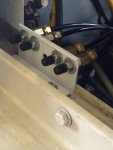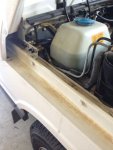Rovers with access height?
- Thread starter bri
- Start date
You are using an out of date browser. It may not display this or other websites correctly.
You should upgrade or use an alternative browser.
You should upgrade or use an alternative browser.
So far as I am aware, all Rovers with air suspension eventually develop a case of access height.
Cheers,
Kennith
Cheers,
Kennith
Ouch!So far as I am aware, all Rovers with air suspension eventually develop a case of access height.
Cheers,
Kennith
I've been using access height on my 08 322 for the last week after my dog's surgery to get him in & out
So far as I am aware, all Rovers with air suspension eventually develop a case of access height.
Cheers,
Kennith
LOL.
I have heard that many times and never experienced it even with stock suspension on the P38, which has a horrible reputation.
So far I am inclined to say that the reputation of the P38 and its air suspension is exaggerated.
Have you owned a Rover with EAS and have any practical advise?
I rebuilt the still functioning EAS on my 95 LWB when I bought it, including new Dunlop bladders. I also carry a spare bladder in the on-board parts kit with a small compressor. I added a manual inflation system so I can inflate each corner, if I have faults that can’t be quickly rectified. I really enjoy the EAS, and this design is 25+ years old. I’m completely confident with mine, and would imagine the newer EAS systems are significantly more reliable.




Last edited:
LOL.
I have heard that many times and never experienced it even with stock suspension on the P38, which has a horrible reputation.
So far I am inclined to say that the reputation of the P38 and its air suspension is exaggerated.
Have you owned a Rover with EAS and have any practical advise?
I never bought one to keep for any appreciable length of time. I have no vehicle specific advice that would be unique or of use at this point.
Generally I'd agree that the problems are a bit exaggerated, but they do exist.
This is one of those things that Land Rover brought to the table a little earlier than they probably should have. I don't think anyone made air suspension that didn't cause one issue or another until the mid 2000s, and here Land Rover is using it on four corners in 1992. That's a full year before anyone beat the fuck out of demons on Mars.
Actually, it's possible that at least one person was at a dealership looking at a new Range Rover with it's newfangled air suspension when they got the call notifying them that their XJ220 was showing up with a V6 instead of a V12. Hell, Pauli Shore was still a bankable star when Land Rover introduced air suspension.
It works, though, and it's not as if it's easy to "break" the systems. There will be some hiccups over time. They tried, and I wouldn't call it a failure of technology. They managed to sell SUVs with air suspension in the early '90s and didn't fall flat on their face in the process, and that's impressive.
I just don't think it was strictly necessary. I've always been more fascinated with that hydraulic rear self-leveling device they were using, that seems to essentially be a "fluid ratchet". I haven't thought about that thing since I owned one, and now I want to go look it up again. That was an elegant idea.
Cheers,
Kennith
I rebuilt the still functioning EAS on my 95 LWB when I bought it, including new Dunlop bladders. I also carry a spare bladder in the on-board parts kit with a small compressor. I added a manual inflation system so I can inflate each corner, if I have faults that can’t be quickly rectified. I really enjoy the EAS, and this design is 25+ years old. I’m completely confident with mine, and would imagine the newer EAS systems are significantly more reliable.
That's pretty sweet.
If you haven't posted your basic process for that in a tech thread, you probably should if you have time.
Cheers,
Kennith
I've always been more fascinated with that hydraulic rear self-leveling device they were using, that seems to essentially be a "fluid ratchet". I haven't thought about that thing since I owned one, and now I want to go look it up again. That was an elegant idea.
Yeah, the Boge self-leveling unit let the early RRC’s get away with relatively soft rear springs. I think they are NLA, and I’ve never owned/driven one, but EAS is a more complicated way to do this at each corner.
Have you owned a Rover with EAS and have any practical advise?
Yes. 2 actually. 1993 RRC LWB. Practical advice - change out EAS for coils and don’t look back. Did the same on my current ‘94 LWB.
I never bought one to keep for any appreciable length of time. I have no vehicle specific advice that would be unique or of use at this point.
Generally I'd agree that the problems are a bit exaggerated, but they do exist.
This is one of those things that Land Rover brought to the table a little earlier than they probably should have. I don't think anyone made air suspension that didn't cause one issue or another until the mid 2000s, and here Land Rover is using it on four corners in 1992. That's a full year before anyone beat the fuck out of demons on Mars.
Actually, it's possible that at least one person was at a dealership looking at a new Range Rover with it's newfangled air suspension when they got the call notifying them that their XJ220 was showing up with a V6 instead of a V12. Hell, Pauli Shore was still a bankable star when Land Rover introduced air suspension.
It works, though, and it's not as if it's easy to "break" the systems. There will be some hiccups over time. They tried, and I wouldn't call it a failure of technology. They managed to sell SUVs with air suspension in the early '90s and didn't fall flat on their face in the process, and that's impressive.
I just don't think it was strictly necessary. I've always been more fascinated with that hydraulic rear self-leveling device they were using, that seems to essentially be a "fluid ratchet". I haven't thought about that thing since I owned one, and now I want to go look it up again. That was an elegant idea.
Cheers,
Kennith
Nice. I agree.
I rebuilt the still functioning EAS on my 95 LWB when I bought it, including new Dunlop bladders. I also carry a spare bladder in the on-board parts kit with a small compressor. I added a manual inflation system so I can inflate each corner, if I have faults that can’t be quickly rectified. I really enjoy the EAS, and this design is 25+ years old. I’m completely confident with mine, and would imagine the newer EAS systems are significantly more reliable.
View attachment 57013
View attachment 57014
Dude! That's pretty cool.
Yes. 2 actually. 1993 RRC LWB. Practical advice - change out EAS for coils and don’t look back. Did the same on my current ‘94 LWB.
IMO. These days, I would keep them as is.
I had an LWB SE that I really wish would have had the EAS intact. Beautiful car. Probably would have sorted out other issues had it had the original EAS. IMO the RRC problems are HVAC just have not seen one that can drive comfortably from -20 to 100F without a lot of work. Given up on them.
For me it depends on actual usage of the Rover. We took this one to Europe while living there and traveled extensively in some pretty remote areas carrying heavy camping gear. The last needed was an EAS failure. Sure one can tinker with it yet not worth the effort vs what you gain. IMHOIMO. These days, I would keep them as is.
On the cool side, having a new heater core and duct work sealed cured that side. However unless under dire conditions it doesn’t see outside the heated garage during Winter anyhow.RRC problems are HVAC just have not seen one that can drive comfortably from -20 to 100F without a lot of work.
On the warm side, the A/C when it worked actually was pretty good. Having a white one helps. Yet now it doesn’t and as we get maybe 4-5 days a Summer in the 90’s decided to just pretend it is a Series Rover without A/C and lower the windows
The ‘95 RRC is the answer to the pre-95 HVAC issues. It basically has the D1 HVAC and a smaller area to heat/cool. Our LWB is certainly at home year round for Mid-Atlantic/New England weather, I just don’t drive it in salt. At highway speeds I generally don’t have the fan on (for heat), just the forced air through the bonnet vents is enough, and the AC is ice cold (fan obviously running).
Back to EAS, one week I may make a straight highway run up to Quebec with four people/gear, next a solo driver for a day or two, then a weekend camping/light-off-road trip, followed by towing a box trailer for a couple days. Compared to my old D1’s uprated suspension (which was best suited to heavier off-pavement loads) EAS is always in the perfect mode regardless of planned usage. I will concede it’s an older, complex system, but the vehicle itself is now 25yo. So, due diligence and oversight is mandatory.
Back to EAS, one week I may make a straight highway run up to Quebec with four people/gear, next a solo driver for a day or two, then a weekend camping/light-off-road trip, followed by towing a box trailer for a couple days. Compared to my old D1’s uprated suspension (which was best suited to heavier off-pavement loads) EAS is always in the perfect mode regardless of planned usage. I will concede it’s an older, complex system, but the vehicle itself is now 25yo. So, due diligence and oversight is mandatory.
Last edited:
I had both a 2000 P38 & 2005 L322 with air suspension.
The P38 got all new air bags, complete rubber replacement inside the valve body, and some software modification to increase "high" height.
I added a fitting for an air line to provide (limited) compressed air out in the world.
I had airspring fails on that, but it was old as shit when it happened.
That car went to just about 165K miles.
The '05 Rangie air suspension was absolutely maintenance-free all the way to the death of that vehicle at around 160K miles.
They both went away because they became economically unfeasible to repair.
The P38 got all new air bags, complete rubber replacement inside the valve body, and some software modification to increase "high" height.
I added a fitting for an air line to provide (limited) compressed air out in the world.
I had airspring fails on that, but it was old as shit when it happened.
That car went to just about 165K miles.
The '05 Rangie air suspension was absolutely maintenance-free all the way to the death of that vehicle at around 160K miles.
They both went away because they became economically unfeasible to repair.